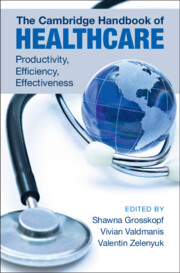Book contents
- Frontmatter
- Contents
- Boxes
- Contributors
- Introduction and Overview
- 1 Overview of Performance Analytics for Healthcare with Examples in R
- 2 Cost-Effectiveness Analysis for Healthcare: From Theory to Practice to Problems and Solutions
- 3 Capabilities, QALYs, and COVID
- 4 The Economic Efficiency of Policies to Reduce Ill Health Involving Environmental Factors
- 5 Health in the National Accounts
- 6 Healthcare as Social Infrastructure: Productivity and the UK National Health Service During and After COVID-19
- 7 Health, Human Capital, and Its Contribution to Economic Growth
- 8 What Do We Know from the Vast Literature on Efficiency and Productivity in Healthcare? A Review and Bibliometric Analysis
- 9 Brief Overview of Production Theory for Analyzing Healthcare Performance
- 10 Modeling Production of Well-Being from an Intermediate Medical Intervention: With an Empirical Demonstration
- 11 Data Envelopment Analysis Applications and US Hospital Policy
- 12 New Tools for Evaluating the Performance of Healthcare Providers Using DEA and FDH Estimators
- 13 Stochastic Frontier Analysis for Healthcare, with Illustrations in R
- 14 A Review of US Stochastic Frontier Studies of Hospital Efficiency Published After 2008
- 15 A Nonparametric Journey through Conditional Frontier Models
- 16 Measuring Health and Healthcare Efficiency: Revised Guidelines for Measurement
- 17 A Brief Introduction to Causal Inference in Healthcare
- 18 Dynamic Assignment of Patients to Primary and Secondary Inpatient Units: Is Patience a Virtue?
- Index
2 - Cost-Effectiveness Analysis for Healthcare: From Theory to Practice to Problems and Solutions
Published online by Cambridge University Press: 21 November 2024
- Frontmatter
- Contents
- Boxes
- Contributors
- Introduction and Overview
- 1 Overview of Performance Analytics for Healthcare with Examples in R
- 2 Cost-Effectiveness Analysis for Healthcare: From Theory to Practice to Problems and Solutions
- 3 Capabilities, QALYs, and COVID
- 4 The Economic Efficiency of Policies to Reduce Ill Health Involving Environmental Factors
- 5 Health in the National Accounts
- 6 Healthcare as Social Infrastructure: Productivity and the UK National Health Service During and After COVID-19
- 7 Health, Human Capital, and Its Contribution to Economic Growth
- 8 What Do We Know from the Vast Literature on Efficiency and Productivity in Healthcare? A Review and Bibliometric Analysis
- 9 Brief Overview of Production Theory for Analyzing Healthcare Performance
- 10 Modeling Production of Well-Being from an Intermediate Medical Intervention: With an Empirical Demonstration
- 11 Data Envelopment Analysis Applications and US Hospital Policy
- 12 New Tools for Evaluating the Performance of Healthcare Providers Using DEA and FDH Estimators
- 13 Stochastic Frontier Analysis for Healthcare, with Illustrations in R
- 14 A Review of US Stochastic Frontier Studies of Hospital Efficiency Published After 2008
- 15 A Nonparametric Journey through Conditional Frontier Models
- 16 Measuring Health and Healthcare Efficiency: Revised Guidelines for Measurement
- 17 A Brief Introduction to Causal Inference in Healthcare
- 18 Dynamic Assignment of Patients to Primary and Secondary Inpatient Units: Is Patience a Virtue?
- Index
Summary
Facing the challenges of aging populations, new technologies provide a potential solution to meeting the increasing needs associated with demographic changes by increasing productivity in healthcare production. However, decision-makers require evidence of whether the adoption of new technologies improves the efficiency of healthcare resource use. Cost-effectiveness analysis (CEA) is a methodology for evaluating new technologies by comparing a new intervention with the current intervention (or mix of different interventions) used for treating the same patient group. This chapter explores the theoretical foundations of CEA and the conditions required for CEA to inform decision-makers about the efficiency of implementing the new intervention are identified. The implications of using CEA as a basis for decision-making in the absence of these theoretical conditions are discussed, and solutions to addressing the efficiency problems under real-world conditions are derived. Where practical considerations limit the ability of decision-makers to apply these solutions, an alternate practical approach, focused on efficiency improvements as opposed to efficiency maximization, is presented.
Keywords
- Type
- Chapter
- Information
- The Cambridge Handbook of HealthcareProductivity, Efficiency, Effectiveness, pp. 65 - 87Publisher: Cambridge University PressPrint publication year: 2024

